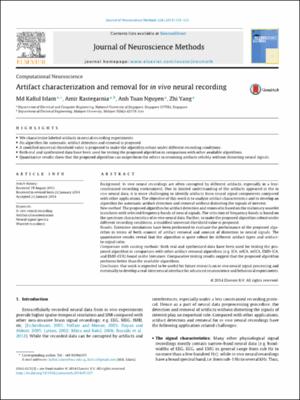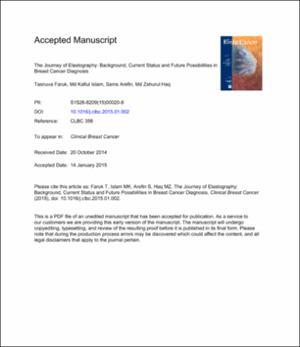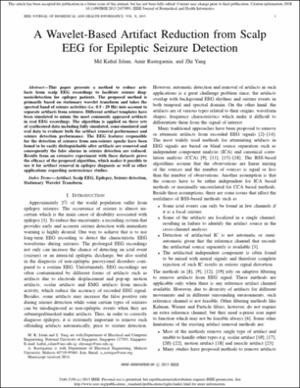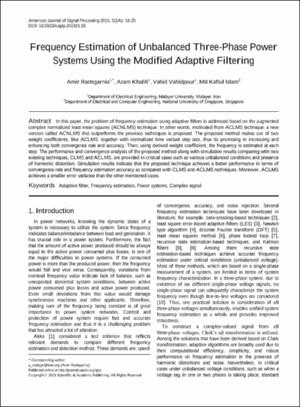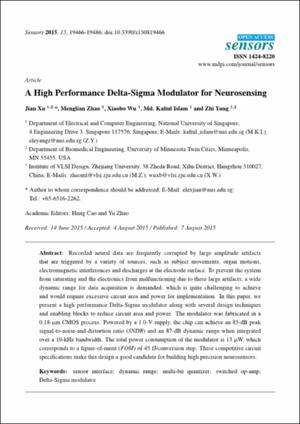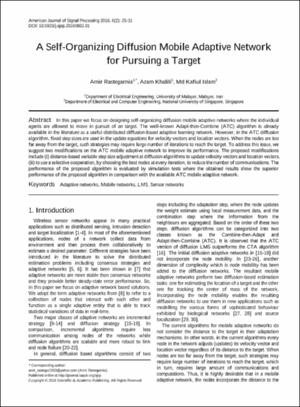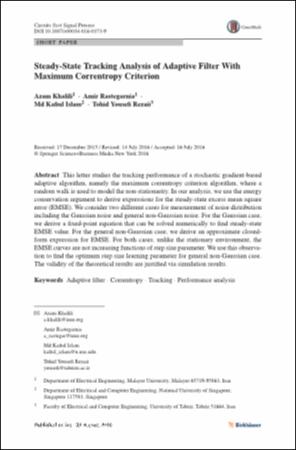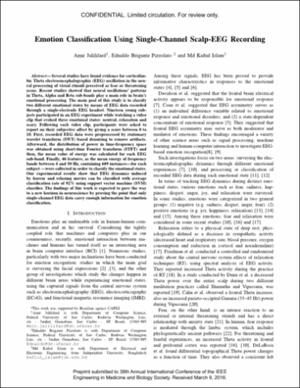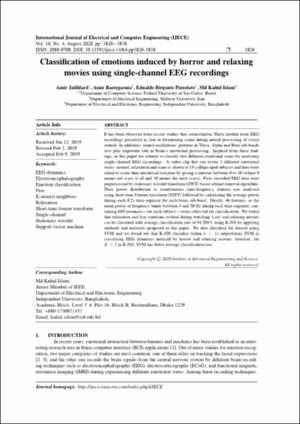Browsing Article by Issue Date
Now showing items 1-20 of 31
-
A 13µW 87dB dynamic range implantable ΔΣ modulator for full-spectrum neural recording
(IEEE, 2013-09-26)Experiment analysis on in-vivo data sequences suggests a wide system dynamic range (DR) is required to simultaneously record local field potentials (LFPs), extra-cellular spikes, and artifacts/interferences. In this paper, ... -
Artifact Characterization and Removal for In-Vivo Neural Recording
(Elsevier, 2014-04-15)Background: In vivo neural recordings are often corrupted by different artifacts, especially in a less-constrained recording environment. Due to limited understanding of the artifacts appeared in the in vivo neural data, ... -
The Journey of Elastography: Background, Current Status and Future Possibilities in Breast Cancer Diagnosis
(Elsevier, 2015)Elastography is a promising way to assess tissue differences regarding stiffness or elasticity for what was historically assessed manually by palpation. Combined with conventional imaging modalities (eg, ultrasonography ... -
A Wavelet-Based Artifact Reduction from Scalp EEG for Epileptic Seizure Detection
(IEEE, 2015-07-15)This paper presents a method to reduce artifacts from scalp EEG recordings to facilitate seizure diagnosis/detection for epilepsy patients. The proposed method is primarily based on stationary wavelet transform and takes ... -
Frequency Estimation of Unbalanced Three-Phase Power Systems Using the Modified Adaptive Filtering
(Scientific & Academic Publishing, 2015-08)In this paper, the problem of frequency estimation using adaptive filters is addressed based on the augmented complex normalized least mean squares (ACNLMS) technique. In other words, motivated from ACLMS technique, a new ... -
A High Performance Delta-Sigma Modulator for Neurosensing
(Sensors, 2015-08-07)Recorded neural data are frequently corrupted by large amplitude artifacts that are triggered by a variety of sources, such as subject movements, organ motions, electromagnetic interferences and discharges at the electrode ... -
Artifact Characterization, Detection and Removal from Neural Signals
(National University of Singapore, 2015-12)Artifact detection and removal are important preprocessing steps for neural recordings to decode the neural signals properly and currently an active research problem. In this thesis, for the first time, artifacts found in ... -
A Self-Organizing Diffusion Mobile Adaptive Network for Pursuing a Target
(Scientific & Academic Publishing, 2016)In this paper we focus on designing self-organizing diffusion mobile adaptive networks where the individual agents are allowed to move in pursuit of an target. The well-known Adapt-then-Combine (ATC) algorithm is already ... -
Steady-State Tracking Analysis of Adaptive Filter With Maximum Correntropy Criterion
(Springer, 2016-08-03)This letter studies the tracking performance of a stochastic gradient-based adaptive algorithm, namely the maximum correntropy criterion algorithm, where a random walk is used to model the non-stationarity. In our analysis, ... -
Methods for Artifact Detection and Removal from Scalp EEG: A Review
(Elsevier, 2016-10-15)Electroencephalography (EEG) is the most popular brain activity recording technique used in wide range of applications. One of the commonly faced problems in EEG recordings is the presence of artifacts that come from sources ... -
Emotion classification using single-channel scalp-EEG recording
(IEEE, 2016-10-18)Several studies have found evidence for corticolimbic Theta electroencephalographic (EEG) oscillation in the neural processing of visual stimuli perceived as fear or threatening scene. Recent studies showed that neural ... -
Probability Mapping Based Artifact Detection and Wavelet Denoising based Artifact Removal from Scalp EEG for BCI Applications
(IEEE, 2019-02-25)In EEG-based Brain-Computer Interface (BCI) applications, the EEG recording is often contaminated by different types of artifacts that can misinterpret the BCI output. Automatic detection and removal of such offending ... -
Design and Implementation of an EOG-based Mouse Cursor Control for Application in Human-Computer Interaction
(IOP, 2020-03-01)Human Computer Interaction (HCI) has turned into an emerging technology due to the advancement in the field artificial intelligence and biomedical engineering. Acquiring different bio-signals such as Electro-oculography ... -
Application of Machine Learning on ECG Signal Classification Using Morphological Features
(IEEE, 2020-06)An electrocardiogram (ECG) is a simple test that is used to check one's heart's electrical activity. Sensors attached to the skin are used to detect the electrical signal produced by one's heart each time it beats. Many ... -
Classification of Emotions Induced by Horror and Relaxing Movies Using Single-Channel EEG Recordings
(Institute of Advanced Engineering and Science (IAES), 2020-08)It has been observed from recent studies that corticolimbic Theta rhythm from EEG recordings perceived as fear or threatening scene during neural processing of visual stimuli. In additions, neural oscillations’ patterns ... -
Use of spontaneous blinking for application in human authentication
(Elsevier, 2020-08)Contamination of electroencephalogram (EEG) signals due to natural blinking electrooculogram (EOG) signals is often removed to enhance the quality of EEG signals. This paper discusses the possibility of using solely ... -
Performance Evaluation of 1kW Asynchronous and Synchronous Buck Converter-based Solar-powered Battery Charging System for Electric Vehicles
(IEEE, 2020-09-05)This paper presents the design and evaluates the system performance of one-kilowatt capacity asynchronous and synchronous buck converter based solar-powered charging systems for battery-driven electric vehicles. The dc ... -
A Web-Based Hospital Automation System for Bangladesh
(International Journal of Pure and Applied Mathematics, 2020-09-21)Medical record-keeping is well advanced in developing countries, but has just begun in developing countries like Bangladesh. The use of electronic medical systems can resolve many chronic inefficiencies and poor service ... -
Dual-Core Photonic Crystal Fiber-Based Plasmonic RI Sensor in the Visible to Near-IR Operating Band
(IEEE, 2020-10-04)In this paper, a dual-core photonic crystal fiber (DC-PCF) based surface plasmon resonance (SPR) bio-compatible sensor is proposed for various bio-organic molecules and biochemical analytes refractive index (RI) detection ... -
Influence of particle shape on the efficacy of plasmonic metal nanoparticles to enhance the energy conversion efficiency of thin-film solar cells
(IEEE, 2020-10-07)The energy conversion efficiency of solar cells can be enhanced significantly due to the effect of coupling the solar cells with plasmonic nanostructures. However, while the advantage of using plasmonic nanostructures has ...

